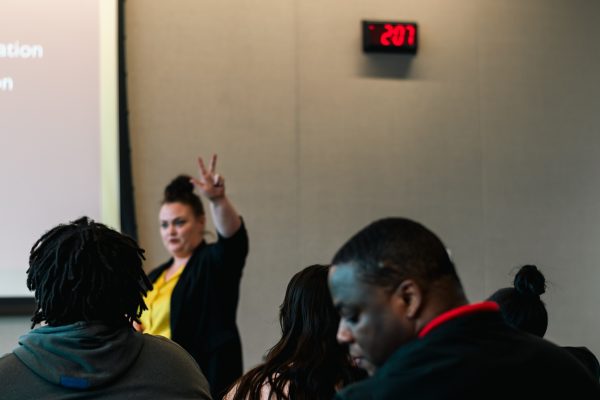Policy prevents campus bullying
Student shares her own experience
October 11, 2012
What started off as innocent hidden whispers soon spiraled into daily bullying.
The bullying expanded to insults, mockery, rumors and eventually lead to isolation. For senior Amanda Clark, years of being bullied turned into more than a torturous daily routine. According to Clark, she first became a victim of bullying in high school.
“There was this sweater I wore to school one day. My mother had bought it for me from the thrift store. Most of the girls in my class didn’t get their clothes from thrift stores and they never let me forget it,” said Clark. “At first, I thought they were my friends. I guess it didn’t help that I was socially awkward. For what started out as just them laughing at me, quickly turned into them whispering behind my back and leaving me mean notes in my books and locker.”
Clark recalled the girls poking fun at her clothes, the way she spoke and walked.
“Common reactions and symptoms to bullying include an increase in feelings of anxiety, depressive symptoms, feelings of loneliness and social isolation. Responses to bullying range on a continuum from mild to severe,” said CAPS psychological counselor Lisa Olson. “[The] duration of bullying, type of bullying and previous experience with bullying in childhood may also be factors.”
According to Olson, if a person was bullied during childhood, they are more likely to have a strong response to bullying when they are adults.
“College students who have a history of being bullied may experience difficulty building new relationships on campus and fear new situations that trigger negative social schemas. All of this can lead to a negative interpretation of the college experience, decreased attendance and difficulties in overall functioning,” Olson said.
The university’s workplace anti-bullying and prevention policy 901-04 states, “Eastern Washington University will not tolerate bullying behavior directed toward any member of the university community or to any person on university property.”
The policy was adopted by the EWU Board of Trustees on Nov. 20, 2009. On Nov. 16, 2010, the policy was revised to include housekeeping changes.
The purpose of the policy stands to manage bullying incidents and establish procedures for how to properly deal with violations and related complaints, according to the policy. The university’s workplace anti-bullying prevention policy can be found online.
The workplace anti-bullying and prevention policy was initiated by Coordinator of Reference Services and Chair of the United Faculty of Eastern Bargaining Team, Suzanne Milton. She created a task force to address bullying in the workplace.
As a result of her efforts, Eastern is the first regional university in Washington state to implement the workplace anti-bullying and prevention policy.
“One of the challenges on a college campus is that many behaviors are not labeled as bullying, and students may dismiss the need for support. As adults, many protections are in place including laws and student conduct codes that address harassment issues,” Olson said.
Faculty, staff and students can seek help from CAPS and the Office of Student Rights and Responsibilities.
“I didn’t have a lot of friends growing up and I used to keep to myself a lot and I never went to any social events,” said Clark. “I met this girl my sophomore year here and we became friends. Turns out she was a victim of bullying too growing up. When you’re a victim of bullying, you don’t typically have a lot of friends who share the same experience or understand why you act certain ways when you’re in a group of people, so being friends with her really helped me I think.”
Most victims have the dilemma of confronting the bully or seeking for help.
“Because there’s a power imbalance, it’s usually very hard to do that. One of the things that schools used to try to do is mediation,” said psychology professor Kurt Stellwagen. “The problem is, it’s kind of the same idea of if you had a rapist and a victim. … Would you want to be in the same room and have the person ask why did you rape me?”
Bullies, who often target more than one person, typically target those that are not physically strong, people who are different from the social norm and individuals usually with a lot of anxiety. Stellwagen says sometimes that is the profile of victims.
Stellwagen says the highest rates of bullying are found among sixth grade boys. According to him, it seems to be because students are coming in from multiple schools and placed into one.
“There’s something called relational bullying which is more associated with females,” said Stellwagen. “Relational bullying is where you try to manipulate relationships, try to get other people to ostracize or reject someone.”
For males, relational bullying tends to occur in a tight friendship group when someone outside of the group wants to join in and the group rejects the individual.
“It tends to decline with age,” Stellwagen said of bullying. Stellwagen says there is a misconception of the parties involved when it comes to bullying and that cases of bullying are not usually where it is just the bully and the victim. There is the bully, the people around the bully, the victim and the people around the victim.
Witnesses and bystanders are part of that outer group. Those individuals often do not intervene in bullying situations because they fear being victimized themselves.
“If you look at the person who becomes the defender of the bullying, often what you’re talking about is someone who is very successful in their own right,” Stellwagen said.
Long term consequences of being a victim of bullying include anxiety and depression. According to Stellwagen, victims who are typically already anxious develop more severe anxiety, panic attacks and school phobia where they are afraid to go to school. Victims also tend not to perform as well in school.
“If you’re being bullied all day, it’s just hard to concentrate on things like math. If you’re thinking once I get out of math I need to go to the bathroom but I’m going to get beat up. It’s a little hard to keep your mind on things,” Stellwagen said.
Long term consequences of being the bully may not appear to be consequences at first. Individuals who Stellwagen describes as “life course persistent” are anti-social individuals who were aggressive in elementary, middle and high school have the potential to be aggressive as adults.
Many people who were bullies as children tend to grow out of bullying, but that is not always the case.
“One of the things you see with people who have those extreme tendencies towards interpersonal manipulation and things like that, they often can rise very high in organizations because they are good at playing the puppet master and they’re ruthless. They often do whatever it is to get ahead,” said Stellwagen. “These people are devious. … They know who to flatter and then who to take advantage of.”






![Simmons said the biggest reasons for her success this year were “God, hard work, and trusting [her] coach and what she has planned.”](https://theeasterner.org/wp-content/uploads/2024/05/image1-1-1200x800.jpg)










